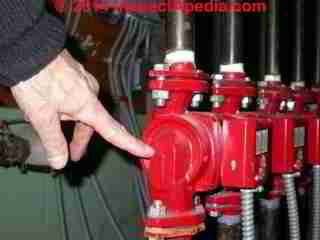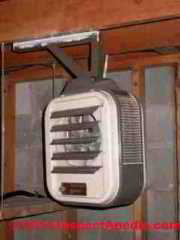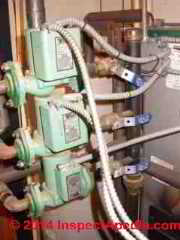 Weak Circulating Pump
Weak Circulating Pump
Diagnose & fix weak circulator pumps
- POST a QUESTION or COMMENT about how to repair weak or insufficient hot water heating zones or circulator pumps
Heating zone too cool, weak heat diagnosis & repair: if your heating baseboard or radiator gets warm but not warm enough to heat the occupied space the problem might be the circulator, the boiler controls, or even the original zone installation piping, sizing, or control valves.
Heating zone pipes that are too small, clogged, blocked, can also cause weak heat delivery. Here we diagnose the trouble with cool heating baseboards or radiators.
This article series describes how to diagnose & fix circulator pump problems on hot water or hydronic heating systems.
InspectAPedia tolerates no conflicts of interest. We have no relationship with advertisers, products, or services discussed at this website.
- Daniel Friedman, Publisher/Editor/Author - See WHO ARE WE?
Weak Heat Questions: baseboards or radiators not hot enough: weak circulator pumps?
 Question: fan convector unit blowing cool air
Question: fan convector unit blowing cool air
(Feb 2, 2013) Gerry said:
When my fan comes on, the boiler temp gauge is showing 180. Right by the gauge is a limit control (clamped onto the pipe) which is set at 180. The temp control on the boiler is at 180. I have no diff control. It is a 11 yr old Weil Mclain boiler with a coil in the duct work.
Which limit control is the hi and which is the low one? When the fan comes on, there is no circulation of hot water through the pipe into the coil. It is warm but slowly cools.
As soon as the burner comes on, the gauge shows 160. and hot water starts circulating. I did have a service person put a new pressure gauge on, he then set the temp gauge on the boiler at about 210, and left the one on the pipe at 180, then he put the pressure up to around 24 psi. It was originally at 15.
What should the limit controls be set at and which one is which? The fan runs blowing cool air until the burner starts, then there is heat. I'm going crazy trying to figure this out. Help!!!!
Reply:
Gerry, if the fan convector you describe is not receiving hot water indeed it'll just blow cool air. Setting the heating boiler HI LIMIT up to 210, as your service tech tried, sounds like a band-aid approach that's unreliable and risks dumping the pressure-relief valve. S/he may have been trying to force hot water through the system hoping that air bleeders and vents will allow self-correction of an air bound system.
Check for a fully or partly air-bound heating system zone piping or radiator or convector
If the circulator pump is running but hot water is not moving through the piping you need to check the diagnostics at AIR-BOUND HEATING SYSTEMS.
Check the position of heating zone control valves
 Watch out: in both a multiple heating zone system that uses multiple circulators and in systems that use individual zone valves and a single circulator there are often control valves before and after the circulator pump (or zone valves). Check the position of these valves.
Watch out: in both a multiple heating zone system that uses multiple circulators and in systems that use individual zone valves and a single circulator there are often control valves before and after the circulator pump (or zone valves). Check the position of these valves.
In a multiple zone heating system it is usually the case that some heating zone piping runs are longer than others, or some zones are more distant from the boiler than others.
When multiple zones are calling for heat at the same time, some zones may be too hot or may heat up quickly while other zones are too cool or heat up too slowly.
The heating technician may fine tune the delivery of heat by partly closing the control valve for a short or close heating zone to give more hot water to the more distant or larger heating zone.
In our photo (left) you can see that the top-most heating zone control valve is in the half-closed position while the two lower zones are in the fully-open position (handle parallel to the direction of the piping).
If a heating zone circulator appears to be working and/or the a zone valve is open and the system is not air bound, the problem could be that someone has closed or partly closed one of the control valves - a step usually taken to better balance heat distribution when multiple heating zones are all calling for heat at once.
Baseboards or radiators not hot enough: weak circulator pumps?
Can a poorly functioning circulator pump cause an insufficient heat supply? I have a tenant who can't get his apartment to heat up to where he's setting his thermostat.
For example, we currently have his thermostat set at 72 degrees & it's only 64 in the apartment & the problem gets worse the colder it is outside.
I had a plumber do a heat loss calculation & there is enough baseboard to heat the space sufficiently. We checked the fins on the baseboards & they are in good, clean condition.
We also replaced the thermostat today just to see what would happen & that hasn't helped either. Any other advice or suggestions? Thank you!
(Jan 26, 2014) Heidi said:
The heat coming from our baseboards is not enough and the boiler goes off even thought the temperature is nowhere near the thermostat set point.
The temperature of the water returning to the boiler is 150, even when the aquastat is set to 220. I am trying to tell if this is a pump problem or an aquastat problem. If the water coming from the valve below the pump is 150 degrees (despite much higher aquastat setting), could the problem still be the pump? The circulator pump feels hot, and there is no visible damage. The pipe at the outlet side of the pump is as hot at the inlet side. Thanks!
(Sept 10, 2011) Melissa Paige Leigh said:
I have repalced the well assembly and relief valve in my hot water tank. Digital stat turns in, kicks burner on then burner shuts off and does not heat water. Any idean what the problem could be.. I bled the burner and ran hot water faucets to ourge any air, oil tank is 3/4 full . Have Taco circulator on supply to hot water tank.
Reply: Quick Summary of where to start if heating baseboards or radiators are not hot enough
- Cold baseboard or radiators: Complete details about diagnosing and fixing cold radiators are found at COLD HEATING RADIATOR REPAIR (hot water / hydronic heat) (for hot water heating systems)
and
at STEAM HEAT RADIATOR REPAIR (for steam heat systems). - Partly-cold heating zones: But a common source of cold baseboards, radiators, or convectors
is AIR-BOUND HEATING SYSTEMS. Particularly if you've heard gurgling water sounds in the heating piping previously, or if you are confident that the heating boiler and its circultors are working, then that's a good place to start. - Other insufficient heat problems can be more subtle such as an improperly-located room thermostat.
See THERMOSTATS, HEATING / COOLING - Boiler trouble: For Melissa, or for other readers complaining of insufficient heat when the boiler itself is not working properly, you'd want to start diagnosing the trouble
at DIAGNOSE & FIX HEATING PROBLEMS-BOILER.
But I make this exception: if the circulator pump is damaged or its relay is not kicking on the pump, the thermostat would call for heat, the boiler would heat up, but as the circulator is idle, no hot water would circulate into the occupied space. In that situation the burner would indeed turn off when the boiler reached its HI LIMIT setting.
Andrea:
Certainly; if the circulator pump is not actually circulating hot water through the heating zone then the zone may still get some heat - by natural convection (hot water rises in the pipes) - but much less than if the circulator were running.
Do this:
- First check that the circulator pump is running itself - the motor runs and there is no visible damage or leakage there.
- Next feel the pipes at the outlet side of the circulator pump and piping - they should get hot.
- Next check for cold baseboards or piping in the too-chilly area.
I'm betting that those pipes are tepid and if you feel along them you'll get to an area where they are downright cold.
If that's the case then the system is probably air-bound. Your plumber or heating tech will need to confirm that theory and then purge air from the system.
You need to check the diagnostics
at AIR-BOUND HEATING SYSTEMS.
What you pose makes some sense to me except that in my experience circulator pumps usually either move water or they don't, excepting further that some circulator pump models provide for variable circulation speeds. When I hear that heat is inadequate and that people are replacing the thermostat, that sounds as if we're shooting in the dark.
Your system might be partly air-bound. In some hot water piping systems air can lurk along horizontal piping runs occupying part of the volume of the pipe interior without totally blocking hot water flow. A result would be reduced hot water flow volume and cooler radiators or baseboards.
Heidi
this is a pretty interesting question. We'd like to know *why* the baseboards don't seem as hot as you want. Usually the problem is a reduced water flow-rate. Slower flowing water (say from a partly-shut valve) means that the room is losing heat fast enough that the baseboards just don't give enough heat to keep up;
Other less common causes: long heating pipe runs through un-heated spaces, damaged circulator impeller, or improperly set heating controls, or thermostat.
I would start by taking a close look at as much of the piping as you can follow by eye and hand. Start at the boiler, follow hot water out of the boiler through the zone valve (if one is installed) or circulator (though we prefer to see the circ on the return side not the supply side of the pipe loop).
Look for a manual valve (a handle or gate valve on the heating pipe) that regulates flow, or look for a little flow control valve and see if it is partly shut. Some HVAC manufacturers call these flow-balancing valves - harder to spot than a valve with a handle, you'll see a fitting on the zone piping (usually near the boiler) with a flat-blade screwdriver slot. If the slot is turned parallel to the pipe the valve is wide open. But if it's at an angle it's partly shut. If it's at right angles to the pipe it's fully closed.
I'll find a photo of this device, post it online and add a comment here pointing to the image.
...
Continue reading at CIRCULATOR OPERATION CHECKS or select a topic from the closely-related articles below, or see the complete ARTICLE INDEX.
Or see these
Recommended Articles
- CIRCULATOR DIAGNOSTICS
- COLD HEATING RADIATOR REPAIR (hot water / hydronic heat)
Suggested citation for this web page
WEAK HEAT, WEAK CIRCULATOR, TOO COOL at InspectApedia.com - online encyclopedia of building & environmental inspection, testing, diagnosis, repair, & problem prevention advice.
Or see this
INDEX to RELATED ARTICLES: ARTICLE INDEX to HEATING BOILERS
Or use the SEARCH BOX found below to Ask a Question or Search InspectApedia
Ask a Question or Search InspectApedia
Try the search box just below, or if you prefer, post a question or comment in the Comments box below and we will respond promptly.
Search the InspectApedia website
Note: appearance of your Comment below may be delayed: if your comment contains an image, photograph, web link, or text that looks to the software as if it might be a web link, your posting will appear after it has been approved by a moderator. Apologies for the delay.
Only one image can be added per comment but you can post as many comments, and therefore images, as you like.
You will not receive a notification when a response to your question has been posted.
Please bookmark this page to make it easy for you to check back for our response.
IF above you see "Comment Form is loading comments..." then COMMENT BOX - countable.ca / bawkbox.com IS NOT WORKING.
In any case you are welcome to send an email directly to us at InspectApedia.com at editor@inspectApedia.com
We'll reply to you directly. Please help us help you by noting, in your email, the URL of the InspectApedia page where you wanted to comment.
Citations & References
In addition to any citations in the article above, a full list is available on request.
- "Instruction Manual, Bell & Gossett Series LR Circulators" P86101D, Mayu 2012, Xylem Inc. 8200 N. Austin Avenue Morton Grove, Illinois 60053 Phone: (847) 966-3700 Fax: (847) 965-8379 www.xyleminc.com/brands/bellgossett
- "Installation and Operation Instructions, Raytherm Residential Boilers," courtesy of Raypak®, and technical advisor Wayne Hoffman, personal communication 5/11/2009. Mr. Hoffman is a technical advisor with more than 30 years experience in the heating field. Raypak is a Rheem company that provides hydronic heating boilers for residential, pool, and commercial use. Raypak can be contacted at 866-583-0664 for technical support or for assistance in selecting the proper heating equipment for a specific application. Rheem Corporation is a manufacturer of water heaters and heating equipment including Ruud heating and cooling products.
- Bell & Gossett Air Separators and other heating system components, 8200 N. Austin Ave., Morton Grove IL 60053, USA - Tel 847 966-3700 Fax 847 965-8379 . Air separators are discussed by B&G at http://www.bellgossett.com/homeowners/BG-airseparator.asp
- Taco air scoops and other heating system components & controls: Taco Inc., 1160 Cranston Street, Cranston, RI 02920 / (401) 942-8000 / Fax (401) 942-2360 Taco (Canada) Ltd., 6180 Ordan Drive, Mississauga, Ontario L5T 2B3 / (905) 564-9422 / Fax (905) 564-9436 www.taco-hvac.com
Taco also has some helpful FAQs that are useful in diagnosing circulator problems - see http://www.taco-hvac.com/en/faq.html# - Sparco air purgers, air scoops, and other heating system components & controls:
- "Residential Hydronic (circulating hot water) Heating Systems", Instructional Technologies Institute, Inc., 145 "D" Grassy Plain St., Bethel, CT 06801 800/227-1663 [home inspection training material] 1987
- Heating, Ventilating, and Air Conditioning Volume I, Heating Fundamentals,
- Boilers, Boiler Conversions, James E. Brumbaugh, ISBN 0-672-23389-4 (v. 1) Volume II, Oil, Gas, and Coal Burners, Controls, Ducts, Piping, Valves, James E. Brumbaugh, ISBN 0-672-23390-7 (v. 2) Volume III, Radiant Heating, Water Heaters, Ventilation, Air Conditioning, Heat Pumps, Air Cleaners, James E. Brumbaugh, ISBN 0-672-23383-5 (v. 3) or ISBN 0-672-23380-0 (set) Special Sales Director, Macmillan Publishing Co., 866 Third Ave., New York, NY 10022. Macmillan Publishing Co., NY
- In addition to citations & references found in this article, see the research citations given at the end of the related articles found at our suggested
CONTINUE READING or RECOMMENDED ARTICLES.
- Carson, Dunlop & Associates Ltd., 120 Carlton Street Suite 407, Toronto ON M5A 4K2. Tel: (416) 964-9415 1-800-268-7070 Email: info@carsondunlop.com. Alan Carson is a past president of ASHI, the American Society of Home Inspectors.
Thanks to Alan Carson and Bob Dunlop, for permission for InspectAPedia to use text excerpts from The HOME REFERENCE BOOK - the Encyclopedia of Homes and to use illustrations from The ILLUSTRATED HOME .
Carson Dunlop Associates provides extensive home inspection education and report writing material. In gratitude we provide links to tsome Carson Dunlop Associates products and services.


